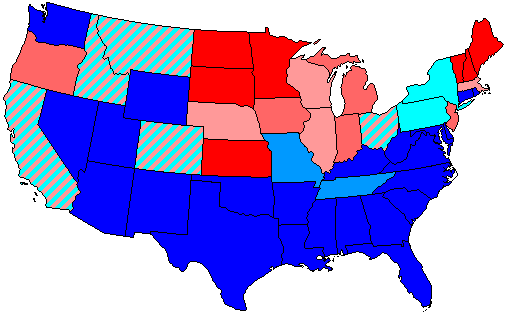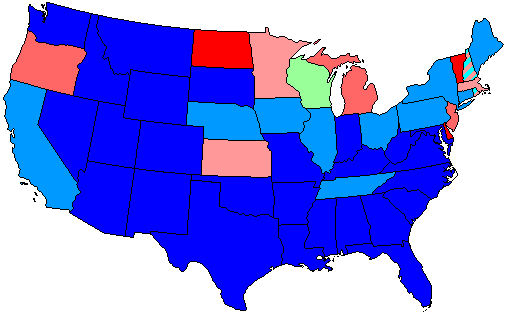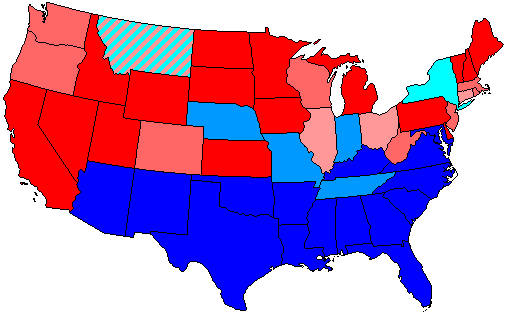|
Minnesota's 9th Congressional District
Minnesota's 9th congressional district is a now-obsolete district for representation in the United States House of Representatives The United States House of Representatives, often referred to as the House of Representatives, the U.S. House, or simply the House, is the Lower house, lower chamber of the United States Congress, with the United States Senate, Senate being ... which existed from 1903 to 1963. It generally consisted of the northwest corner of the state (parts of the current day 7th congressional district). List of members representing the district References * * Congressional Biographical Directory of the United States 1774–present {{DEFAULTSORT:Minnesota's 9th Congressional District 09 Former congressional districts of the United States 1903 establishments in Minnesota 1963 disestablishments in Minnesota ... [...More Info...] [...Related Items...] OR: [Wikipedia] [Google] [Baidu] |
Minnesota State Highway 9
State Highway 9 or Trunk Highway 9 (MN 9, TH 9) is a state highway in west-central and northwest Minnesota, which runs from its intersection with MN 23 in New London and continues west and then north to its northern terminus at its intersection with US Highway 2 (US 2) in Fairfax Township near Crookston. This highway has two distinct segments, a north–south section and an east–west section, connected by US 75 between Doran and Breckenridge. Route description MN 9 serves as a north–south and east–west route between New London, Benson, Morris, Breckenridge, Barnesville, Ada, and Crookston in west-central and northwest Minnesota. Monson Lake State Park is located west of Sunburg and west of the junction of 9 and MN 104. The park entrance is located off MN 9 via County Road 95 (CR 95). A portion of the route passes through the Red River Valley The Red River Valley is a region in centr ... [...More Info...] [...Related Items...] OR: [Wikipedia] [Google] [Baidu] |
Knud Wefald
Knud Magnus Wefald (November 3, 1869 – October 25, 1936), was an American Minnesota Farmer–Labor Party politician who served as a member of the United States House of Representatives from Minnesota's 9th congressional district from 1923 to 1927. Background Knud Magnus Wefald was born in Yttre Vefald, Drangedal, in Kragerø, Telemark county, Norway. He attended the local schools and high school of his native land. He immigrated to the United States in 1887 and in 1896 settled in Hawley, Clay County, Minnesota, where he engaged in agricultural pursuits while managing a partly owned lumber business. Career As a member of the village council of Hawley he served as council president in 1907-1912, 1917, and 1918. He was a member of the Minnesota House of Representatives from 1913 to 1915. Wefald was elected on the Farmer-Labor ticket to the 68th and 69th Congresses (March 4, 1923 – March 3, 1927) from Minnesota's 9th congressional district. After an unsuccessful camp ... [...More Info...] [...Related Items...] OR: [Wikipedia] [Google] [Baidu] |
1940 United States House Of Representatives Elections In Minnesota
The 1940 United States House of Representatives elections coincided with President Franklin D. Roosevelt's re-election to an unprecedented third term. His Democratic Party narrowly gained seats from the opposition Republican Party, cementing their majority. However, the election gave firm control of the US House of Representatives and Senate to the New Dealers once again, as Progressives dominated the election. The upswing in the economy that occurred following the Recession of 1937–38 encouraged voters that the New Deal plan had been working. This allowed the Democrats to stabilize their support. As of 2022, this is the last time the House of Representatives was made up of six parties. Overall results SourceElection Statistics - Office of the Clerk Special elections Many special elections were held. The elected winner would serve only the remainder of the incumbent Congress. Sorted by election date. , - ! , Carl Mapes , , Republican , 1912 , , Incu ... [...More Info...] [...Related Items...] OR: [Wikipedia] [Google] [Baidu] |
1938 United States House Of Representatives Elections In Minnesota
The 1938 United States House of Representatives elections was an election for the United States House of Representatives in 1938 which Midterm election, occurred in the middle of President of the United States, President Franklin D. Roosevelt's second term. Roosevelt's United States Democratic Party, Democratic Party lost a net of 72 seats to the United States Republican Party, Republican Party, who also picked up seats from minor Progressive and Farmer–Labor Parties. Multiple factors contributed to the Democratic decline. One main reason was the Recession of 1937. Unemployment soared, undercutting the Democrats' claim that the New Deal had ended the Great Depression. Democrats fought among themselves, especially over Judicial Procedures Reform Bill of 1937, Roosevelt's "Court Packing" plan. In addition, there was backlash against Roosevelt's intervention in the Democratic primaries which angered conservative Democrats. The labor unions, which were emerging as a powerful grassr ... [...More Info...] [...Related Items...] OR: [Wikipedia] [Google] [Baidu] |
1936 United States House Of Representatives Elections In Minnesota
The 1936 United States House of Representatives elections were elections for the United States House of Representatives in 1936 that coincided with President Franklin D. Roosevelt's landslide re-election. Roosevelt's Democratic Party gained twelve net seats from the Republican Party, bringing them above a three-fourths majority. This was the largest majority since Reconstruction, as the last time a party won so decisively was in 1866. This is the last time any party held 3/4ths of all House seats. Significant representation from the Progressives of Wisconsin and Farmer–Labor Party of Minnesota is also seen, as these two liberal populist groups gained a foothold. The 1936 elections showed the continuing trust for the American people in that Roosevelt would guide the nation from depression. Despite setbacks, the people had faith in the New Deal and elected leaders who supported its measures. This was the last of four straight election losses for Republicans due to the lingering ... [...More Info...] [...Related Items...] OR: [Wikipedia] [Google] [Baidu] |
1934 United States House Of Representatives Elections In Minnesota
The 1934 United States House of Representatives elections were held in the middle of President Franklin D. Roosevelt's first term. The Democratic Party continued its progress, gaining another 9 net seats from the opposition Republican Party, who also lost seats to the Progressive Party. The Republicans were reduced below one-fourth of the chamber for the first time since the creation of the party. The Wisconsin Progressive Party, a liberal group which allied with the Democrats, also became a force in Wisconsin politics. The 1934 elections can be seen as a referendum on New Deal policies. While conservatives and people among the middle class who did not bear the brunt of the depression saw New Deal programs as radical, lower-income voters overwhelmingly voted in this election cycle to continue the implementation of Roosevelt's agenda. This marked the first time that an incumbent president's party did not lose seats in both houses in a midterm election, followed by 1998 and 2002. ... [...More Info...] [...Related Items...] OR: [Wikipedia] [Google] [Baidu] |
Rich T
Rich may refer to: Common uses * Rich, an entity possessing wealth * Rich, an intense flavor, color, sound, texture, or feeling **Rich (wine), a descriptor in wine tasting Places United States * Rich, Mississippi, an unincorporated community * Rich County, Utah * Rich Mountain (other) * Rich Township, Cook County, Illinois * Rich Township, Anderson County, Kansas * Rich Township, Lapeer County, Michigan Elsewhere * Er-Rich, Morocco, a town * Rich River, Victoria, Australia People * Rich (given name), often short for Richard * Rich (surname) Arts, entertainment, and media Fictional characters * DS Terry Rich, a character in the British soap opera ''EastEnders'' * Rich, a character in the American sitcom television series ''The Hogan Family'' * Rich Halke, a character in the TV sitcom '' Step by Step'' * Rich Hardbeck, a character in the British television series ''Skins'' * Richie Rich (comics), a fictional character Music * Rich, half of the American coun ... [...More Info...] [...Related Items...] OR: [Wikipedia] [Google] [Baidu] |
1930 United States House Of Representatives Elections In Minnesota
The 1930 United States House of Representatives elections was an election for the United States House of Representatives in 1930 which occurred in the middle of President Herbert Hoover's term. During the election cycle, the nation was entering its second year of the Great Depression, and Hoover was perceived as doing little to solve the crisis, with his personal popularity being very low. His Republican Party was initially applauded for instituting protectionist economic policies, which were intended to limit imports to stimulate the domestic market: however, after the passage of the heavily damaging Smoot-Hawley Tariff, a policy that was bitterly opposed by the Democratic Party, public opinion turned sharply against Republican policies, and the party bore the blame for the economic collapse. While the Democrats gained 52 seats in the 1930 midterm elections, Republicans retained a narrow one-seat majority of 218 seats after the polls closed versus the Democrats' 216 seats; ho ... [...More Info...] [...Related Items...] OR: [Wikipedia] [Google] [Baidu] |
1928 United States House Of Representatives Elections In Minnesota
The 1928 United States House of Representatives elections was an election for the United States House of Representatives in 1928 which coincided with the election of President Herbert Hoover. The strength of the U.S. economy resulted in Hoover's Republican Party victory in the election, helping them to scoop up 32 House seats, almost all from the opposition Democratic Party, thus increasing their majority. The big business-supported wing of the Republican Party continued to cement control. Republican gains proved even larger than anticipated during this election cycle, as an internal party feud over the Prohibition issue weakened Democratic standing. Losses of several rural, Protestant Democratic seats can be somewhat linked to anti-Catholic sentiments directed toward the party's presidential candidate, Al Smith. However, this would be the last time for 68 years that a Republican House was re-elected. Results summary SourceElection Statistics - Office of the Clerk Speci ... [...More Info...] [...Related Items...] OR: [Wikipedia] [Google] [Baidu] |
1926 United States House Of Representatives Elections In Minnesota
The 1926 United States House of Representatives elections was an election for the United States House of Representatives in 1926 which occurred in the middle of President Calvin Coolidge's second term. Coolidge's Republican Party lost seats to the opposition Democratic Party, but it retained a majority. The most pressing national matters at the time were fragmented, generally related to government's relationship to business or to providing social aid. However, no predominant issue was able to cast a shadow over the election. The small, populist Farmer–Labor Party also held two seats following the election. Overall results Source: Special elections Elections are listed by date and district. , - ! , John E. Raker , , Democratic , 1910 , , Incumbent died January 22, 1926.New member elected August 31, 1926.Republican gain. , nowrap , , - ! , Lawrence J. Flaherty , , Republican , 1924 , , Incumbent died June 13, 1926.New member elected August ... [...More Info...] [...Related Items...] OR: [Wikipedia] [Google] [Baidu] |
Conrad Selvig
Conrad George Selvig (October 11, 1877 – August 2, 1953) was a Republican member of the United States House of Representatives. Biography Conrad George Selvig was born in Rushford, Minnesota. He was the son of Gunder C Selvig (1842–1935) and Guri Maria Hagnestad Selvig (1845–1882), immigrants from Stavanger, Norway. His father worked for the Chicago, Milwaukee, and St. Paul Railroad. Conrad Selvig fought in the Spanish–American War as a member of the 12th Minnesota Volunteer Infantry. He graduated from Rushford High School (1895) and the University of Minnesota (1908). He worked as an educator and educational administrator for various school districts in Fillmore County, Minnesota and Crookston, Minnesota during his lifetime. In 1910, Selvig was appointed as Superintendent of the Northwest School of Agriculture in Crookston, Minnesota where he served for 17 years. He also served as president of the Minnesota Education Association (1908–1909) and the Northwestern Minn ... [...More Info...] [...Related Items...] OR: [Wikipedia] [Google] [Baidu] |






